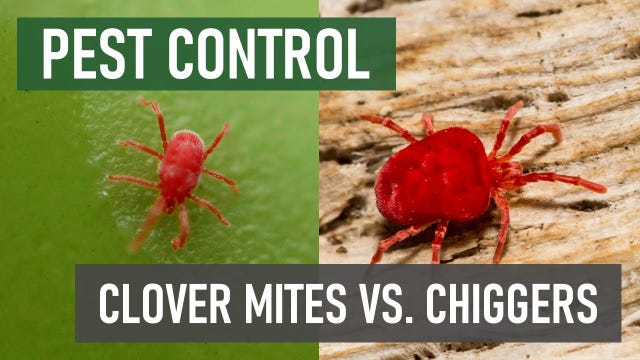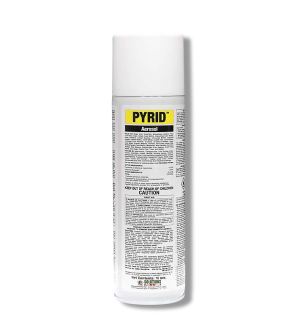Gain access to personalized product screening, the best pricing, rewards, and more!
Most Effective Products
Clover Mites Vs. Chiggers: Difference Between Chiggers and Clover Mites
This article is a general DIY guide that tells the difference between clover mites and chiggers. These pests may seem similar in appearance, but they each pose their own issues and damages for homeowners. To kill clover mites and chiggers around or inside of your home, then follow the links for professional product recommendations and steps to eliminate the pest.
When it comes to tiny red bugs, identification is the key to determining the best form of control. The more you know about these tiny red bugs invading your home or yard, the better prepared you will be to eliminate them.
Clover mites and chiggers are two tiny red bugs that are commonly mistaken for one another. They are experienced throughout the spring and fall seasons with their biting activities and ability to produce large populations. Clover mites are a common pest that feeds on clovers, grasses, and other ornamentals, whereas chiggers prefer to eat the skin cells they dissolve with their spit.
Regardless of the pest invading your home or yard, there are steps you can take to get rid of chiggers and clover mites. Though both pests may seem similar, they differ in behavior, appearance, damage, and more. Effective control solutions are available by learning more about these pests throughout this DIY guide and the recommended products to eliminate them.
Appearance

While clover mites and chiggers are all but impossible to differentiate from a glance completely, it can be done. To know what clover mites and chiggers look like, then refer to the physical differences throughout this section.
For a physical example, refer to the image above. A clover mite is on the left side of the image above, while a chigger is on the right side.
Size
- Clover mites are small red bugs measuring about 1/30th of an inch long, visible to the human eye.
- Chiggers are half the size of clover mites at 1/60th of an inch long, meaning they need to be seen with a microscope.
Legs
- Clover mites are not considered insects but a relative of spiders and ticks. They have eight legs and an oval-shaped body, and their two front legs are elongated, often causing them to be mistaken for antennae.
- Like clover mites, chiggers are also akin to spiders and ticks with their eight legs. With their almost strawberry-shaped bodies, red coloration, and identical number of legs, it can be hard to tell chiggers from clover mites. However, clover mites have elongated legs while the chigger does not.
Where Do Clover Mites and Chiggers Live

Clover mites are usually found outdoors on foliage along the perimeter of your home and around entry points like doors, windows, cracks, and crevices. In cooler weather, they can invade indoors and infest house plants as they look for warmth and shelter.
Chiggers only remain outdoors and do not travel indoors. They prefer moist, overgrown wooded habitats with shaded soil. They can also be found around lakes, swamps, and rivers.
Do Clover Mites or Chiggers Bite

Though clover mites do infest indoors, they do not bite people. They feed by piercing plants and ingesting the sap.
If you are being bitten, more than likely, it is by larval chiggers, as adult chiggers do not bite. Larval chiggers feed on their host's skin cells, leaving behind itchy red bumps or welts. The bites are typically found around the waist, ankles, behind the knee, and body parts where the clothing is tight.
Are Clover Mites and Chiggers the Same
Although clover mites and chiggers are both small red arachnids, they are physically different, with the clover mites having longer front legs than the chigger. Both of these pests are their own separate species, but they share some similarities, such as both are red in coloration and congregate in large groups.
Key Takeaways
What do Chiggers and Clover Mites Eat?
- Chiggers, particularly the larvae stage, dissolve the skin cells of people or animals until dead, then feast on them, leaving behind a series of red bumps. Between these two, clover mites are the only pest that travels indoors and feast on plant material.
How Long Do Chiggers and Clover Mites Live
- When there are favorable conditions, the chigger can live between 50 to 70 days. Clover mites tend to survive from 1 to 2 weeks outdoors but can only live for a couple of days indoors due to dehydration.
How to Get Rid of Clover Mites
- To get rid of clover mites, mix and apply 0.25 to 0.5 fl. oz. of Supreme IT. Broadcast the mixed solution over your lawn and any shrubs or ornamentals on your property. Then, spray any entry points outside your home, like doors, windows, vent openings, and other voids in the wall. Once you have treated entry points, conduct a perimeter treatment around your structure by spraying 3 feet up the structure and 3 feet out around its perimeter. Avoid overlapping this application with your prior treatment. This will kill clover mites in the applied areas and prevent them from invading your home or structure. To kill clover mites infesting house plants, directly treat them with Pyrid Insecticide Aerosol. This product is made with 0.5% Pyrethrins and the synergist piperonyl butoxide. Pests that come in contact with the spray will have their nervous systems impacted and will be immediately knocked down.
How to Get Rid of Chiggers
- To get rid of chiggers, first, you will need to mow your lawn to its proper height, then trim any overgrown shrubbery to reduce their harborages. Then, mix and apply 1 fl. oz. of Supreme IT. Like with clover mites, you will broadcast your mixed solution over your lawn and any shrubs or ornamentals on your property. Since chiggers do not typically invade indoors, you do not need to spray entry points or around the perimeter, but we recommend you do so to prevent other pests from coming inside.
-
Q:I have 2 dogs that constantly chew on their paws. Are they being bitten by chiggers? I don't even walk in the yard because I am deathly allergic to fire ants, however, I am being bitten on my feet and ankles every time I take the dogs outside, but I stay on the front patio that is covered with outside carpet. Could they be on the carpeting? What do I do about the fire ants mounds? They are everywhere. We can't afford to pay anyone to mow our property anymore as we lost a large part of our income ($750/month). What do you think we should do?8/3/25










